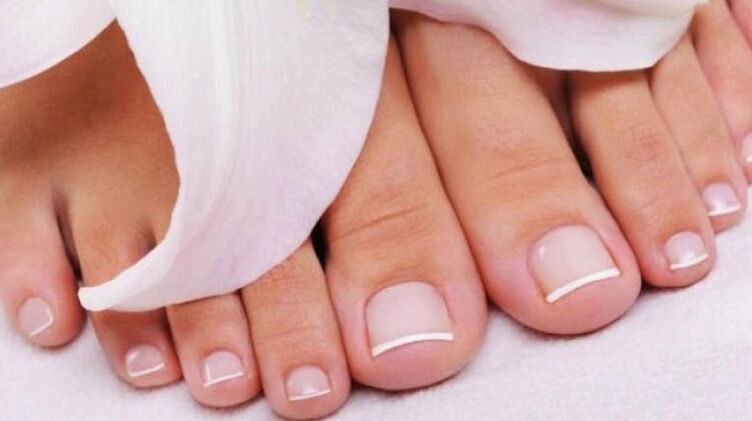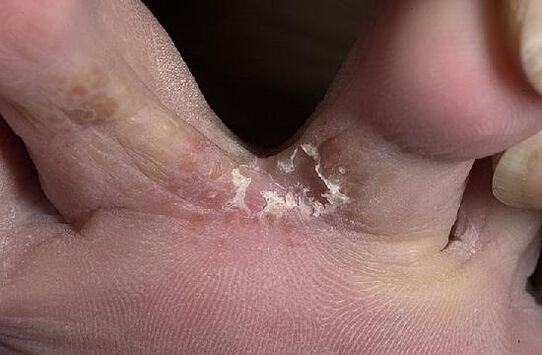A third of the European population is ill with foot mycosis. These are data from studies conducted in all European countries. Fungus on the feet most often begins with interdigital folds, for the following reasons:
These are data from studies conducted in all European countries. Fungus on the feet most often begins with interdigital folds, for the following reasons:
- vascular disease of the legs (21%);
- obesity (17%);
- foot pathology - narrow interdigital space, diabetic foot, flat foot (15%);
- trauma to the skin, nails and fingers due to tight shoes, sports injuries, edged pedicures.
Favorite place of occurrence of foot mycosis - the tightest space between the toes 3, 4, 5. From there, the fungus affects all interdigital folds, the skin of the palms with side edges, the back of the feet, nails
How to recognize foot mycosis? Symptoms of foot fungus
- Cracks or funnels appear between the toes, the edges of which are covered with whitish (greenish) skin whitish or greenish;
- Cracks may weep with exudate;
- Circular diaper rash with flaky skin appearing under and between the fingers (interrelated symptoms);
- With the flow between the toes removed, the cracks are almost invisible, but the exfoliation resembles flour (the skin looks as if sprinkled with flour-this is the scales that are affected). Symptoms often occur in children;
- There was a slight itching between the fingers, but no major discomfort.
In a "dormant" state, which is obliterated, the fungus between the toes can remain forever, hiding the symptoms. But the process will increase. Gradually, the skin appears drier, rough, rough, scaly, acquires a gray-yellow-gray color, horns to calcification, cracks in very rough places.

Simultaneously or sequentially, stages of onychomycosis occur - nail lesions that change color, thicken, peel and collapse. They reach such an end stage, when symptoms clearly indicate long -term health neglect.
The second way of fungal development between the fingers is more rare (about 8%). This is a "wet", vesicular or exudative fungus, in which there is an exploding vesicle and subsequent ulceration. Wet mycosis between the toes affects people with severe stress, with long rises, wearing bad, tight shoes, without ventilation, with improper fungal therapy, with self -treatment with antimycosis and corticosteroids.
If you sabotage the treatment of fungus between the toes, 80-100% of patients will be exposed to toenails, 20% - on the hands. Her appearance was sad and disgusting, the nails looked like crumbling dust or laundry soap. It can also lead to the appearance of "vulture claws" or grow on. Toenails that grow inwards are also a painful treatment.
How to cure interdigital fungus?
Although all these symptoms appear after many years, you should immediately treat the fungus between the fingers, as it is a highly contagious and contagious infection.
We went to a dermatologist. Before treating, he makes a friction of his finger and examines it using a microscope, culture or DNA analysis. Microscopy reveals filaments or spores of the mycelium.
Systemic treatment consists of taking tablets or capsules with antimycotics. They accumulate in the horn tissue, enter through the blood, and destroy the fungus for several weeks after taking the drug
The disadvantage is that systemic drugs are quite hepatoxic (they have an adverse effect on the weakened liver), and therefore the treatment can not be used in people with diseased liver, pregnant women, lactating women, young and old. The type of drug depends on the nature of the pathogen. If the symptoms are unclear and the type cannot be ascertained, treatment with broad -spectrum medications is prescribed. The use of systemic medications is still at risk; at a later stage, such drugs need to be treated for a long time.
You can also treat with local remedies applied to the lesion. Such drugs often have a variety of effects, and kill fungi and bacteria. The treatment is long and intense, so you should immediately tell the doctor if your funds are limited.
Home therapy and prevention of fungal infections. It is not useful to treat the fungus yourself. The information allows us to talk about incredible resilience and high recurrence potential.
Prevention is an effective remedy.
- Check with family members for fungal symptoms. Intrafamilial contamination is common. All need to be treated;
- Don’t use other people’s shoes, socks, pedicure sets, don’t wipe with regular towels;
- Not all fungi die even at a temperature of 100 degrees Celsius, but an important part - yes, so wash bedding and bath linen at a temperature of 90 degrees;
- Get rid of shoes with antimycotin spray once a month, bathroom surface once a week;
- In public, don’t go barefoot, and do pedicures in disinfected salons;
- For fungal prevention, you can use antimycotic ointment, which is applied on clean and dry feet;
- Do not wear shoes until your feet are dry.
Dermatologists also advise to do a pedicure at least once a month and a half, removing dead tissue. In themselves, fungi like to settle. Better to be careful than to cure later.
At the clinic, you can undergo an examination and consult a dermatovenerologist.
















